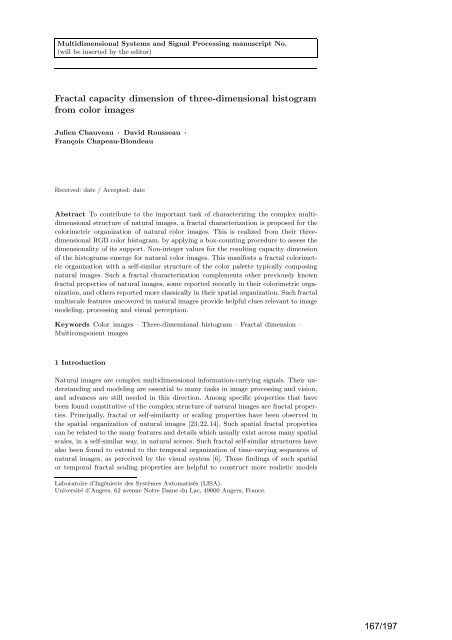a la physique de l'information - Lisa - Université d'Angers
a la physique de l'information - Lisa - Université d'Angers
a la physique de l'information - Lisa - Université d'Angers
You also want an ePaper? Increase the reach of your titles
YUMPU automatically turns print PDFs into web optimized ePapers that Google loves.
Multidimensional Systems and Signal Processing manuscript No.<br />
(will be inserted by the editor)<br />
Fractal capacity dimension of three-dimensional histogram<br />
from color images<br />
Julien Chauveau · David Rousseau ·<br />
François Chapeau-Blon<strong>de</strong>au<br />
Received: date / Accepted: date<br />
Abstract To contribute to the important task of characterizing the complex multidimensional<br />
structure of natural images, a fractal characterization is proposed for the<br />
colorimetric organization of natural color images. This is realized from their threedimensional<br />
RGB color histogram, by applying a box-counting procedure to assess the<br />
dimensionality of its support. Non-integer values for the resulting capacity dimension<br />
of the histograms emerge for natural color images. This manifests a fractal colorimetric<br />
organization with a self-simi<strong>la</strong>r structure of the color palette typically composing<br />
natural images. Such a fractal characterization complements other previously known<br />
fractal properties of natural images, some reported recently in their colorimetric organization,<br />
and others reported more c<strong>la</strong>ssically in their spatial organization. Such fractal<br />
multiscale features uncovered in natural images provi<strong>de</strong> helpful clues relevant to image<br />
mo<strong>de</strong>ling, processing and visual perception.<br />
Keywords Color images · Three-dimensional histogram · Fractal dimension ·<br />
Multicomponent images<br />
1 Introduction<br />
Natural images are complex multidimensional information-carrying signals. Their un<strong>de</strong>rstanding<br />
and mo<strong>de</strong>ling are essential to many tasks in image processing and vision,<br />
and advances are still nee<strong>de</strong>d in this direction. Among specific properties that have<br />
been found constitutive of the complex structure of natural images are fractal properties.<br />
Principally, fractal or self-simi<strong>la</strong>rity or scaling properties have been observed in<br />
the spatial organization of natural images [23,22,14]. Such spatial fractal properties<br />
can be re<strong>la</strong>ted to the many features and <strong>de</strong>tails which usually exist across many spatial<br />
scales, in a self-simi<strong>la</strong>r way, in natural scenes. Such fractal self-simi<strong>la</strong>r structures have<br />
also been found to extend to the temporal organization of time-varying sequences of<br />
natural images, as perceived by the visual system [6]. These findings of such spatial<br />
or temporal fractal scaling properties are helpful to construct more realistic mo<strong>de</strong>ls<br />
Laboratoire d’Ingénierie <strong>de</strong>s Systèmes Automatisés (LISA),<br />
<strong>Université</strong> d’Angers, 62 avenue Notre Dame du Lac, 49000 Angers, France.<br />
167/197


